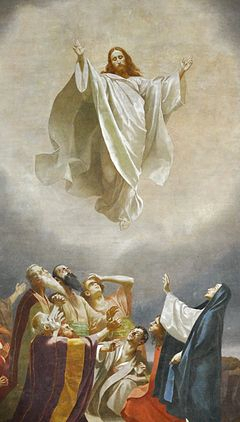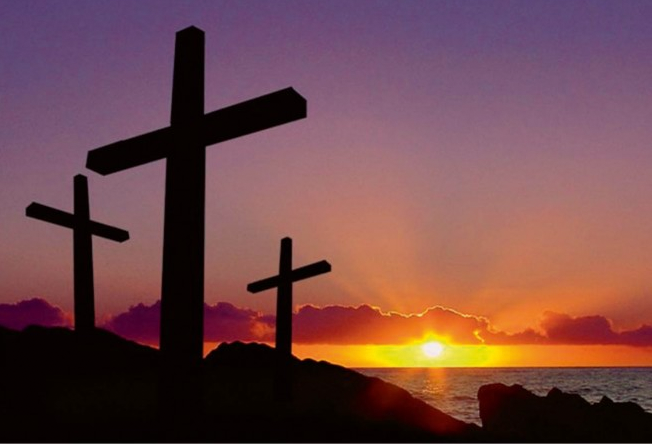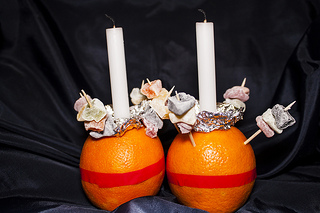Clergy Reflection Jan-Jun 2019
Each month, one of our clergy team contributes an item to our Parish Magazine that is designed to provoke thought and reflection about a topical issue. For recent articles, see below.
June 2019: 1994 and all that
I wonder if you can remember 1994. Can you picture yourself a quarter of a century ago and think back to the world as it was then? What has changed since 1994? What has stayed the same? On the one hand Britain had a Conservative government, with a vulnerable leader trying to manage a party riven by disagreement over Europe. So maybe some things don't change much. On the other, England failed to reach the World Cup finals in 1994, whereas now we seem to have one of the best football teams in the world. So maybe they can.
One thing changed in 1994. For centuries the priesthood of the church of England had been exclusively male. But after a long period of discussion and debate, a decision was made in 1992 to open up the priesthood to female candidates. It took another eighteen months for parliamentary process and vocational discernment to be completed, and in the Spring of 1994 the first women priests in the Church of England were ordained.
It was quite a moment. Women had been ordained as deacons since 1987, so there was a large number of candidates yearning and ready to grasp the calling which they believed the church had been frustrating for years. Huge ordination services with scores of ordinands were held, among them one in St Albans Cathedral in April of that year. I was able to attend the massed ordination in Sheffield Cathedral that Spring, and it was an electrifying occasion which I'll never forget.
The ordination of women to the priesthood was a big change in the Church of England, and it's hard now to imagine the Anglican church without it. It's something that I believe also reached out and touched our wider culture - and not just through The Vicar of Dibley! But it should be recalled that at the time it was very controversial, and for sincere theological reasons a good number of Anglicans could not welcome it. Some have found ways to remain within our church; many have left Anglicanism in a variety of directions.
While respecting that women’s ordination brought hurt and confusion to some, I do want to mark this anniversary with clear thanksgiving and joy. My principal reason for this is the experience of women priests I have served alongside, over the 25 years of my own ordained ministry. In every post I have held I have had women priestly colleagues, and I truly believe that the shared ministry I have tried to exercise has been richly blessed and enriched by being a partnership of women and men.
High in the firmament of women priests I have collaborated with is our friend June Knight. It feels a happy serendipity that we can mark June's silver jubilee of priesthood at the same time as we mark the national anniversary. And we will do this at a special service on 23rd June at 10 a.m. to which you will be very welcome. A chance to give thanks for June: all she has done, all she does and all she'll go on to do. A moment for gratitude for the ministry of women priests over a quarter-century. And an opportunity to thank God for his constancy in the ever-changing times of our lives. Please come along and join in our offering of praise.
Blessings, Derwyn.
May 2019 - Up?
 I wonder, are you feeling 'up' today? Are you ‘on top of the world’, 'on cloud nine’ or 'up in the seventh heaven’? Has something ‘lifted' your mood, or are you 'on a high'?
I wonder, are you feeling 'up' today? Are you ‘on top of the world’, 'on cloud nine’ or 'up in the seventh heaven’? Has something ‘lifted' your mood, or are you 'on a high'?
So much of our language about feelings has to do with location. And the place where we want to be with feelings is definitely 'up'! Days when we are 'down', or 'under the weather’, or feeling 'low’ are the ones we want to avoid. When it comes to emotions 'up' is good and 'down' is bad. Just like thumbs.
Springtime is approaching, and for many people it's a time when we feel a bit more 'up', as the weather warms. Like the sky we might well feel 'bright' and 'sunny'. Our mood becomes less 'dark’ and ‘gloomy’ as light fills the world after the darkness of winter. For as well as the language of location, our feelings use language of light and shade. ‘Dark’ and 'down' are bad, 'up ‘ and 'bright' are good, when it comes to our mood.
The month of May is historically a time of celebration, as bright flowers shoot up and the light lifts spirits. Maybe it's just connected with higher levels of vitamin D! But for Christians the month of May also brings a festival which should make us look, and feel 'up'. It's called the Ascension, and falls on Thursday 30th May this year.
At the Ascension Jesus goes 'up'. He ascends vertically through the clouds, leaving the depths of earth, to enter the highest heaven. There's a lot of language about location in the story. But I wonder if the meaning is in the metaphor. The story tells us that Jesus is ending up 'on top’. He's the ‘top man’. He's 'exalted’ to a new 'raised' status in the presence of God. Like Tiger Woods he's bounced back and reached the top of the tree.
And that should make us, his followers, feel a little bit 'up' as well. Yes, there are moments when our life and our worship take us 'down'. We need to acknowledge our sin, and lament the pain of the world. Following Jesus isn't just mindless cheery
optimism. But the Ascension says that Jesus has won. He's overcome all that drags us down and puts us low. He raises us from sin and death and pain. He's been exalted and wants us to share his exaltation. So when we celebrate the Ascension, on 30th May and again on Sunday 2nd June, may we let it raise our spirits and lift up our hearts? Like Jesus, it's a feast that should also give us a 'high’.
Derwyn
April 2019 - Broken and Restored
Often in our prayers we pray for the ‘broken’ world in which we find ourselves. Each of us could probably write a wide ranging list of what we mean by a ‘broken’ world – brokenness in the relationships between nations states, in the destructive influence man is having on his environment, in the extremism of certain philosophies and religions, in the excesses of the irresponsible use of power, and, at an individual level, in the rising tide of divorce and in the apparent inability of people, at all levels in our society, to enjoy their lives and interests without the use of drugs, or alcohol or some other artificial stimulant.
Recently an example of this ‘brokenness’ was brought home to us when, one night in February, two men broke into the church, caused quite a lot of damage, stole a few small items of silverware, and fled. Why did they do this? From what has transpired since, it is unlikely that these two men were motivated by some anti-Christian or anti-church sentiment, but much more likely by their desperation to find some money to fuel their dependence on drugs. Those of us who have been involved with cleaning up the church, and praying for its healing and restoration, have had cause to reflect on the brokenness of these two people’s lives and how that might have come about. Our emotions have been torn between a desire to apprehend and punish, and the imperative to love your neighbour and forgive. The damage to the church is not ultimately important; but the effect of this incident has been to draw members of the community closer together. We have set about restoring and cleansing the building, and prayed that it will continue to be a focus for the wider community of Bishop’s Stortford. Within two days of this sad event, the church was open again for anyone to come, pray, worship, or just be quiet, as it has been for many centuries – a reminder that part of our mission is to be an example of community life where life in all its abundance can continue to be enjoyed.
The most significant damage done by our intruders was to the two crosses on the altars. The very heavy cross on the high altar, which has on it the figure of the Lord risen in glory, was used as a battering ram and ended up with the top of the cross bent over. The smaller nave altar cross had also been used to try to gain entry to the vestry and was completely broken. I hope the irony of these broken crosses has not escaped you. The cross, the great universal symbol of the Christian faith, is itself a symbol of brokenness, pain and death, one of the most barbaric ways of killing ever invented. Yet we hear from the cross words of forgiveness, words of compassion, words of the thirstiness, words of victory, words of promise, words of utter desolation, and words of commendation into God’s hands. Here is a powerful mixture of brokenness and restoration, of despair and hope, of injustice and forgiveness, of death and resurrection. These are the themes that will, or should be occupying our minds, our prayers and our actions as we meet Jesus again on the road to Jerusalem during Lent and Holy Week. If you really want to capture the joy and celebration of Easter, you should give yourself a chance by entering in to at least part of the Lent and Holy Week programme, which you will find elsewhere. Experience the foreboding atmosphere on Maundy Thursday; the United Service at the URC and silent march on Good Friday; the devotional three hour service at St Michael’s on Good Friday; the promise and surprise of resurrection early on Easter morning and our celebration later. Throughout these days we shall continue to pray for our broken world as we draw closer to Jesus, who was broken for us, expressed in these lovely words:
Broken for me, broken for you,
The body of Jesus broken for you.
He offered his body, he poured out his soul,
Jesus was broken that we might be whole:
Come to my table and with me dine,
eat of my bread and drink of my wine:
This is my body given for you,
eat it remembering I died for you:
This is my blood I shed for you,
for your forgiveness, making you new:
Broken for me, broken for you,
The body of Jesus broken for you.
With my love and prayers for a very blessed Easter.
Derek
February 2019 - Happy Birthday, Christingle!!

It was some time in the 1970s, I can’t quite remember exactly when. News went round the village (by word of mouth in those days) that something new was happening. There would be a special service called a Christingle, with a collection to support The Church of England Children’s Society. I knew a little about the Children’s Society, to give it its modern, abbreviated title, since we collected funds for it each December when we sang carols around the village. And the Christingle service sounded interesting. So I went along.
I don’t remember much about the service, except that the Christingles, when they appeared, looked rather strange objects, to my boyish mind. An orange with some red tape around it, four cocktail sticks pointing upwards out of the fruit, with raisins skewered upon them. And a candle in the middle, which no doubt we lit. Presumably we were told about the symbolism of the Christingle: of the orange which represents the world God has made, the fruits which represent his gifts to us, the ribbon showing us Christ’s loving blood-sacrifice which surrounds the world, and his light represented by the candle shining in the darkness. I seem somehow to have ‘always’ known what the Christingle means. But I mainly recall thinking that the Christingle service was very different from Matins, which I usually went to, and wondering if this strange new ritual would catch on.
My village’s first Christingle was one of the early ones held in the Church of England. The idea started at Lincoln Cathedral in 1968. So this Christingle season has marked the 50th anniversary of its introduction to England. Happy Birthday, Christingle!
Originating as a Moravian tradition, the Christingle was taken up by the Children’s Society as a way to share Christ’s message of light, as well as raising funds and awareness of its work as a charity. Many Christingle services continue as ‘Children’s Society’ services. But the Christingle has taken on a life of its own, now popping up in churches and schools in all sorts of contexts and formats. For some people it’s their annual moment to come to church.
I still feel a bit of my boyhood ambivalence about the Christingle and wonder about its attraction. I guess for the children there are the sweets (which seem to have displaced the raisins of my youth). And for the adults there’s the prospect of seeing small children’s faces lit by candlelight and gazing in wonder. But when I use my imagination and really think about all its symbols, I begin to see its power. I think of the world, so small. And so precious, like an orange to an eighteenth century Moravian. I think of my fortune in enjoying such an abundance of the earth’s fruits. And I think of the cost of Jesus’ love, its grand embrace of us all, and the light it brings to our darkness. When I really think about the Christingle I’m grateful for it, and for the pioneers who brought it here when I was small.
Perhaps you come to our Christingle every winter. It’s on 3rd Feb at 10 am this year. Maybe you haven’t come to one for ages, or perhaps it’s just not an occasion for you. But if you’d like to join us in this anniversary season, to worship Christ, remember old times, share the wonder, or just give thanks for 50 years of Christingle, you’ll of course be most welcome.
May Christ’s light be with us always.
Derwyn